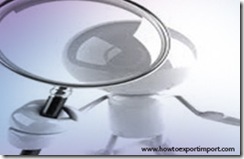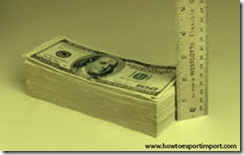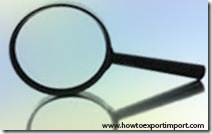Difference between first check appraisement and second check appraisement in imports
What is First Check Appraisement in Imports? How does second check appraisement work in import customs clearance procedures? Why do an importer request customs for First check procedures under import customs clearance formalities? Can imported goods be examined / inspected before import customs clearance?
A legal document called bill of entry has to be filed with customs department against goods arriving from other country. The cargo has to be value appraised. In certain case of imports, the importer does not know the exact quantity or quality of goods received from his overseas buyer. Or in some other cases the importer may have a dispute or suspect on quality of goods arriving. The importer complete customs clearance and take delivery of cargo to his place means, he has taken ‘delivery of goods’. So, before taking delivery of goods or before completing import customs clearance procedures, importer wants to confirm on the quality, quantity or contents of the consignment shipped by his overseas supplier. He can approach concerned customs appraising officer and request for ‘first check appraisement’.
goods arriving from other country. The cargo has to be value appraised. In certain case of imports, the importer does not know the exact quantity or quality of goods received from his overseas buyer. Or in some other cases the importer may have a dispute or suspect on quality of goods arriving. The importer complete customs clearance and take delivery of cargo to his place means, he has taken ‘delivery of goods’. So, before taking delivery of goods or before completing import customs clearance procedures, importer wants to confirm on the quality, quantity or contents of the consignment shipped by his overseas supplier. He can approach concerned customs appraising officer and request for ‘first check appraisement’.
In some other cases, the customs officials may order for first check procedures to have a thorough inspection of goods before value assessment.
 If Bill of Entry is filed manually – without electronically - the importer or their customs broker completes the ‘entry procedures of import’ and requests the concerned customs appraising officer to mark ‘open examination order’. After obtaining the necessary open order from the appraiser, the customs broker or importer approaches concerned customs personnel to inspect the cargo.
If Bill of Entry is filed manually – without electronically - the importer or their customs broker completes the ‘entry procedures of import’ and requests the concerned customs appraising officer to mark ‘open examination order’. After obtaining the necessary open order from the appraiser, the customs broker or importer approaches concerned customs personnel to inspect the cargo.
At a customs location, where in electronic facility is available, the importer requests customs officials of first check procedures or the customs officials order for first check procedures depends up on the nature of goods imported.
The goods are inspected completely or partially as per the requirements, and prepare report on examination of goods. The Samples of commodity is drawn for quality check, if the importer or customs needed. Once after confirming and satisfying the quality, quantity and contents of consignment, the importer proceed further in completing import customs clearance procedures to take delivery of cargo. If he is not satisfied with the goods, he informs his overseas supplier about his dispute. If dispute could not be settled each other, the cargo is abandoned ‘un cleared’.
dispute. If dispute could not be settled each other, the cargo is abandoned ‘un cleared’.
Once after completing the reporting of inspection either electronically or manually if no electronic filing system available, the appraisement procedures are carried out. The importer takes delivery of cargo after payment of duty if any.
In second check appraisement, the examination of cargo takes place after value appraisement. Once after filing Bill of entry by CHA or importer, the document transfers to value appraiser. The concerned value appraising group asses the value and appraise the goods after verifying the necessary documents submitted. Once after completion of appraisement of goods, the goods are inspected.
In a first check assessment, the examination of goods is carried out before appraisement and in second check assessment, the examination of goods are done after appraisement of goods. This is the major difference between first check appraisement and second check appraisement.
I hope, I could clarify the difference between first check and second check in import customs clearance procedures. I have tried to make you clear about first check and second check under import clearance procedures in simple language to make you easily understand.

Do you wish to add more information about first check and second check procedures of value assessment in import customs clearance procedures? Share below your experience in handling import customs clearance procedures on first check and second check procedures and formalities.
The above information is a part of Online Export Import course
Discuss below about First Check Procedures and Second check procedures under import customs clearance procedures and formalities under Import.
Other post about import export cauching
Is Letter of Credit LC safe for an Importer?
Mode of payments in international trade
Difference between importer and Consignee
Bank Release Order (BRO) or Bank Delivery Order in Imports
Difference between IGM and Bill of Entry
How to start Export Business?
How to get Export Orders?
What are the risks and solutions in Export Business?
Click here to know India Trade Classification(ITC)
Service Tax - Click here to read complete notification under Budget 2014
What is Bank post shipment credit to exporters?
Types of export containers
Measurement of export containers
Exim Policy of India 2015-20
MEIS, Merchandise Exports from India Scheme
SEIS, Service Exports from India Scheme
Merge your Commercial Invoice and Packing List for all your future exports
Export procedures and documentation
Zero rate of GST on sale of Fresh Krill
No need to pay GST on sale of plant dry root
Exempted of GST on sale of live woodlice
Nil rate of GST on sale of live lobster
No GST on sale of live barnacles
Zero rate of GST on sale of Fresh woodlice
Nil rate of GST on sale of Fresh Shrimp
No need to pay GST on sale of Fresh Lobsters
Zero percentage of GST on sale of Fresh Crayfish
Exempted GST on sale of fresh crabs
Nil rate of GST on sale of Crustaceans whether in shell or not
Waived GST on sale of cooked woodlice
Nil rate tariff GST on sale of cooked shrimp
Nil rate of GST on sale of cooked lobsters
Nil rate of GST on sale of cooked crayfish
No need to pay GST on sale of chilled woodlice
Nil tariff GST on sale of chilled shrimp
Zero percentage GST chilled lobsters
No need to pay GST on sale of chilled krill
Nil rate of GST on purchase of chilled crayfish
No GST on purchase of chilled crabs
Exempted GST on sale of chilled barnacles
No need to pay GST on sale of Boiled shrimp
No need pay GST on sale of Boiled barnacles
No need to pay GST on purchase of live shrimps
Zero rate of GST on sale of live crabs
No need to pay GST on sale of Fresh barnacles
Zero rate of GST on purchase of cooked crabs
No GST on sale of Boiled crayfish
No need pays GST on sale of Boiled woodlice